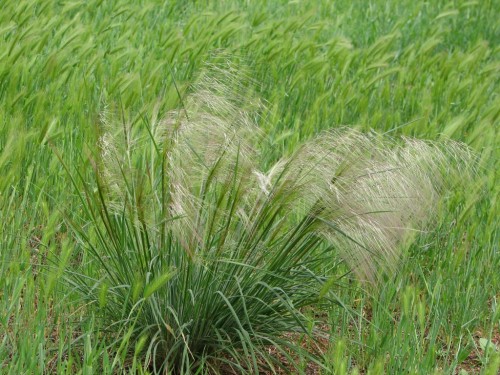Australian Native Grasses
Yesterday I went to a native grasses identification workshop organised by the Native Grasses Resource Group (NGRG) which is based at Mt. Barker in South Australia, about 20 minutes from Adelaide. The workshop was at Mount Pleasant. It was aimed at beginners, which I am, and I hope will give me a few skills to build on so that I can get a reasonable identification of the grasses on our property. Over the last five years I have seen the return of eight species of native grass. There are two more sessions next month. One will be with samples and books, the last out in the field.
The Spear Grasses are well named as the seeds penetrate socks and are quite sharp. They can be a problem with sheep. Apparently there are trials happening with getting stock onto paddocks with spear grass to eat them before seed is set. Being perennial grasses, they resprout when the conditions are right.
I like the plumes on these grasses. This one in the photo was taken last spring after good winter rains as can be seen by the barley grass in head, also. That paddock was mown twice. This year there hasn’t been the growth to warrant mowing.
Sowing Grass Seed
I have been putting in seed this week. I’m only a few weeks behind! I like to have the seed in by the end of March, so I have lost some critical propagation time.
Anyway, where I have been working, I have a view of the yard and all the activities of the birds. We are very fortunate here in that we have a large population of resident species and we get to see many species which are seasonal visitors. The exception is the water birds as we are a bit far from the river.
I found a supply of native grass seed which I had missed earlier and now is a good time to put the seed in. I am still learning about the optimum time for various species. We have Austrostipa species which flower from late winter to summer. There are also the summer growing species, like Chloris truncata (Windmill grass) which gives nice patches of green in an otherwise brown landscape, apart from the trees and shrubs. I probably haven’t got the sowing times correct.
Anyway, for better or worse I planted
- Austrostipa nitida, (Spear Grass)
- Austrodanthonia setacea (Wallaby Grass)
- Cymbopogon ambiguus (Lemon Grass)(Not the one used in Asian cooking!)
- Chloris truncata (Windmill Grass)
- Enneapogon nigricans
All of these are local species.
Grasses at the Zoo
Husband was really keen on seeing the birds in the Asian Rainforest area as well as the other aviaries at the Zoo. He was able to take some lovely photos. In the smaller aviaries where Australian birds are kept it was, of course, more difficult to take photos with the netting in place. He can’t tick these off his list because of his rule-it has to be seen in the wild to be ticked. However observing helps with identification.
What interested me was the increased use of grasses in many of the aviaries. I am still learning to identify the South Australian species which are local, but it appeared that SA species were being used. Because of the height of the plants, the birds were using them for shelter and foraging. Dried grass would have been used for nesting material. There was no seed left on the plants at this time of the year but the birds would have loved the seed panicles last season.
Something that I had promised husband was a number of potted grasses to rotate through his aviary for the finches. I must do this for him instead of just talking about it. When the plants become tatty they can be trimmed and tidied, while other pots replace them. He wants to landscape the aviaries, and this would be one way of doing this.
We have always had our compatible interests. When we go bird watching we are also plant watching because each is dependent on the other.
Native Grasses
Talk about famous last words! I was looking at a proposed site to set up a plant sales area and discovered in my wanderings a nice new patch of Horehound. The last lot of decent rain was enough to germinate seed while the soil is still warm. I noticed the onion weed has shot again also, so there is a lot of work ahead in the next week or so after Plant Sale in Adelaide.
One great thing I did notice were the native grasses which have returned to our block. They have sprouted new growth. The Austrostipa species are looking like lawn at the moment. There are a couple that I would like to get going as lawn substitutes in areas where a ‘lawn’ would be growing.
The small patch of Enneapogon nigricans is looking quite lush. The larger area of Austrodanthonia caespitosa is looking great too. As this patch has grown, there has been an excellent suppression of weeds. In fact wherever the native grasses have colonised the weedy plants have diminished.
I have had some species identified by members of the Native Grasses Resource Group, based in Mt Barker, about 30minutes from Adelaide. This group is worth joining if you have any level of interest in Native grasses.
Assistance and information are given to enable whatever your level of interest to be satisfied.
